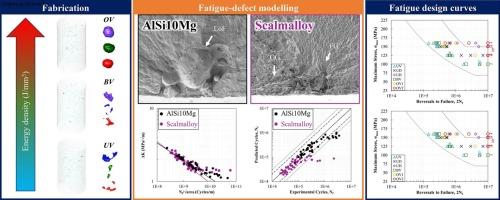Fatigue-defect criticality in laser powder bed fused aluminum alloys
IF 5.6
2区 工程技术
Q1 ENGINEERING, MECHANICAL
引用次数: 0
Abstract
This study investigated the influence of volumetric defects on the fatigue behavior of laser powder bed fused AlSi10Mg and Scalmalloy, two aluminum alloys with distinct microstructures and potentially different defect sensitivity. Specimens were fabricated in three orientations with different energy inputs, to intentionally induce volumetric defects of varying geometries at reasonable populations. The stress-life fatigue data for both alloys exhibited significant scatter, owing to the differences in the defect characteristics of specimens. Fatigue notch factor-based life estimations, relying on the fatigue limit as a function of the critical defect size, were found to be effective in predicting the stress-life behavior for AlSi10Mg. For Scalmalloy, the location of the defects relative to the bimodal grain structure, as well as some fine-grained regions often serving as crack initiation sites, introduced significant uncertainty in the fatigue limit predictions. As a result, crack growth-based models —instead of notch factor-based ones— were able to sufficiently describe the fatigue behavior of both alloys, with predictions either within a scatter band of 3 or on the conservative side of experimental fatigue lives.

激光粉末床熔合铝合金的疲劳缺陷临界
本文研究了体积缺陷对激光粉末床熔敷AlSi10Mg和Scalmalloy两种具有不同显微组织和不同缺陷灵敏度的铝合金疲劳行为的影响。用不同的能量输入在三个方向上制造样品,以在合理的种群中有意地诱导不同几何形状的体积缺陷。由于试样缺陷特征的差异,两种合金的应力-寿命疲劳数据呈现出明显的离散性。基于疲劳缺口因子的寿命估计,依靠疲劳极限作为临界缺陷尺寸的函数,被发现可以有效地预测AlSi10Mg的应力-寿命行为。对于Scalmalloy,相对于双峰晶结构的缺陷位置,以及一些经常作为裂纹起裂部位的细晶区域,在疲劳极限预测中引入了很大的不确定性。因此,基于裂纹扩展的模型——而不是基于缺口因子的模型——能够充分描述两种合金的疲劳行为,预测结果要么在3的散射带内,要么在实验疲劳寿命的保守侧。
本文章由计算机程序翻译,如有差异,请以英文原文为准。
求助全文
约1分钟内获得全文
求助全文
来源期刊

Theoretical and Applied Fracture Mechanics
工程技术-工程:机械
CiteScore
8.40
自引率
18.90%
发文量
435
审稿时长
37 days
期刊介绍:
Theoretical and Applied Fracture Mechanics'' aims & scopes have been re-designed to cover both the theoretical, applied, and numerical aspects associated with those cracking related phenomena taking place, at a micro-, meso-, and macroscopic level, in materials/components/structures of any kind.
The journal aims to cover the cracking/mechanical behaviour of materials/components/structures in those situations involving both time-independent and time-dependent system of external forces/moments (such as, for instance, quasi-static, impulsive, impact, blasting, creep, contact, and fatigue loading). Since, under the above circumstances, the mechanical behaviour of cracked materials/components/structures is also affected by the environmental conditions, the journal would consider also those theoretical/experimental research works investigating the effect of external variables such as, for instance, the effect of corrosive environments as well as of high/low-temperature.
 求助内容:
求助内容: 应助结果提醒方式:
应助结果提醒方式:


